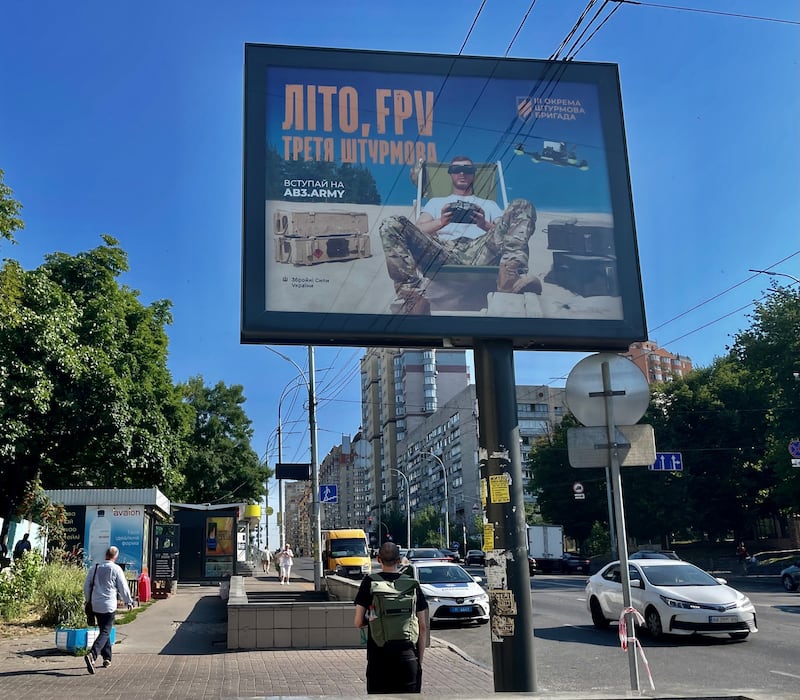Ukraine is trying to replenish its army by expanding the pool of potential conscripts, ensuring fewer of them flee abroad, and by enlisting Ukrainians in prison and in Poland, but the draft and attempts to dodge it are still divisive issues after nearly 2½ years of all-out war.
The stream of volunteers that poured into Ukraine’s armed forces at the start of Russia’s full-scale invasion in early 2022 has long since dried up, amid rising casualties on a battlefield where Russia has had the upper hand for well over a year.
Ukraine overhauled its mobilisation rules in April, lowering the conscription age to 25 from 27, making fewer people exempt from military service and increasing punishments for draft dodgers. Frontline soldiers also got a pay rise, but not a sought-after guarantee that conscripts would be released after 36 months of service.
Ukraine’s armed forces do not reveal how many people they want to enlist or have already drafted, but the defence ministry says 2.3 million citizens have updated their details in the military register via a new digital app ahead of a July 16th deadline.
The various branches of the military and individual regiments are now competing for recruits with advertising campaigns on television, online and on countless billboards across the country, where they urge men and women to sign up for the unit of their choice rather than leaving it – for the men, at least – to the lottery of conscription; women cannot be mobilised in Ukraine, but most men aged 18-60 are eligible.

New recruitment centres are also inviting in Ukrainians to discuss military career options in a welcoming environment, and the defence ministry has started posting thousands of vacancies in the armed forces on leading job-search websites.
Yet this drive to make the transition to military life as easy as possible – starting with a simple click on a QR code – coexists alongside draft offices that are still widely regarded as bastions of corruption and Soviet-style disregard for citizens’ rights and welfare.
Ukrainian president Volodymyr Zelenskiy sacked the heads of all regional military conscription centres last August, when he railed against “illicit enrichment, legalisation of illegally obtained funds... illegal transfer of persons liable for military service across the border” and other “revolting practices” in the draft system.
Nearly a year on, however, barely a day passes without graft allegations being made against conscription officers or people trying to evade the draft by paying bribes or fleeing the country – some of whom die in desperate attempts to cross the border.
Hundreds of people are facing corruption cases, ranging from peddlers of fake medical exemptions to the former head of the Odesa region’s enlistment office, who allegedly used bribes from draft dodgers to buy property in Spain worth millions of euro.
Telegram channels with thousands of followers reveal the movements of conscription teams around towns and cities to men who are trying to avoid them, while footage of civilians brawling with enlistment officers or blocking their vehicles is common – Ukraine says some such clips are staged by Russia and its supporters.
While trying to catch those who attempt to leave illegally, Ukraine is also now releasing some prisoners early to join the army – about 3,000 at the latest count
The BBC’s Ukrainian service reported last November that EU data showed some 650,000 Ukrainian men of conscription age had left the country since Russia’s all-out invasion in February 2022, although it was not clear how many had a valid exemption.
Ukrainian border guard chief Andriy Demchenko said in April that about 120 people were being prevented from leaving the country every day, while about 30 people had died during the full-scale war trying to swim and trek into EU states and Moldova.
While trying to catch those who attempt to leave illegally, Ukraine is also now releasing some prisoners early to join the army – about 3,000 at the latest count – under a scheme that the justice ministry estimates could be open to some 27,000 convicts.
[ Anastasiia lives in Connemara, Dasha in Zaporizhzhia: A family divided by warOpens in new window ]
Kyiv says it is not mimicking a Russian programme under which tens of thousands of criminals were freed to join the armed forces and the now-disbanded Wagner mercenary group, some of whom subsequently returned to civilian life and committed further brutal crimes; in Ukraine, those convicted of multiple murders, sex crimes or crimes against national security are not eligible.
Ukraine knows that EU states will not send Ukrainian citizens of fighting age home, but is looking for ways to encourage its growing diaspora to join the defence of its homeland.
Poland, which is home to at least two million people from Ukraine, has decided to create a volunteer unit of Ukrainians that will be trained and equipped there.
“We are starting to prepare the first Ukrainian brigade consisting of volunteers in Poland... and several thousand [Ukrainians] have already registered to participate,” Polish foreign minister Radoslaw Sikorski announced this week.
“Many of them really want to serve... but say they don’t want to be sent into battle without being properly trained and equipped. And we’re going to do this for them,” he said.
“And then they will be available to the Ukrainian government as a unit with the right to return to Poland after their rotation,” he added. “If every European country did this, there would be several [new] brigades in Ukraine.”
- Sign up for push alerts and have the best news, analysis and comment delivered directly to your phone
- Find The Irish Times on WhatsApp and stay up to date
- Our In The News podcast is now published daily – Find the latest episode here





















